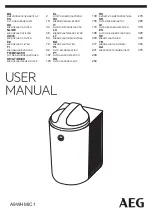
4
5
FM
Madas Technical Manual
- 6|6.3 - REV. 0 of 1
th
Oct 2018
4.0 FIRST STARTUP
• Before start-up, make sure that all the instructions on the rating plate, including the direction of flow, are observed;
• After having gradually pressurised the system, check the tightness and operation of the filter.
4.1 - RECOMMENDED PERIODIC CHECKS
• Use a suitable calibration tool to ensure the bolts are tightened as indicated in 3.2;
• Check the tightness of the flanged/threaded connections on the system;
• Check the tightness and operation/efficiency of the filter;
The final user or installer is responsible for defining the frequency of these checks based on the severity of the service conditions.
5.0 MAINTENANCE
• Before carrying out any dismantling operation on the device, make sure that there is no pressurised gas inside.
REPLACING THE FILTER ELEMENT (2)
• Remove the cover (
1
) by loosening the fastening screws (
5
);
• Extract the filter element and check its conditions. Blow it and clean it and, if necessary, replace it.
• Reassemble it in its initial position, checking that it is placed between the special guides (
4
) (see fig. 1-2-3);
• Check the conditions of the sealing O-ring (
6
) of the cover (
1
), and replace it if necessary (recommended);
• Make sure the O-ring (
6
) of the cover (
1
) is inside the provided groove;
• Reassemble the cover and secure it in its original position, being very careful not to “pinch” or damage the O-ring during tightening;
• Tighten the screws (
5
) gradually, following a “cross” pattern, until the torque (tolerance -15%) indicated in the table below
is reached. Use a calibrated torque wrench to do this.
• Check the body/cover seal.
Screw
M5
M6
M8
M10
M12
Galvanised
Stainless
Steel
Galvanised
Stainless
Steel
Galvanised
Stainless
Steel
Galvanised
Stainless
Steel
Galvanised
Stainless
Steel
Max. torque (N.m)
6
4.5
10
7.5
25
18.5
49.5
37
84.5
63.5
6.0 TRANSPORT, STORAGE AND DISPOSAL
• During transport the material needs to be handled with care, avoiding any impact or vibrations to the device;
• If the product has any surface treatments (ex. painting, cataphoresis, etc.) it must not be damaged during transport;
• The transport and storage temperatures must observe the values provided on the rating plate;
• If the device is not installed immediately after delivery it must be correctly placed in storage in a dry and clean place;
• In humid facilities, it is necessary to use driers or heating to avoid condensation.
• At the end of its service life, the product is to be disposed of in compliance with the legislation in force in the country where
this operation is performed.
























